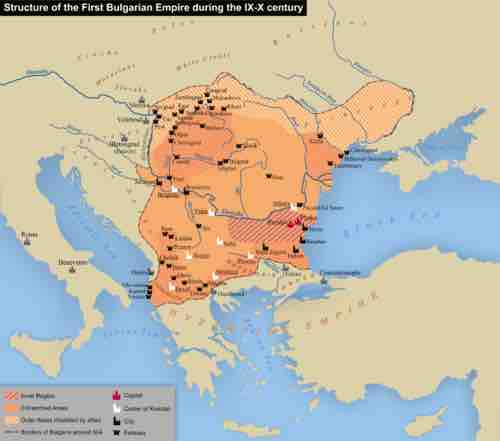The Bulgarian Empire
The First Bulgarian Empire was a medieval Bulgarian state that existed in southeastern Europe between the 7th and 11th centuries AD. It was founded circa 681 when Bulgar tribes led by Asparukh moved to the northeastern Balkans. There they secured Byzantine recognition of their right to settle south of the Danube by defeating — possibly with the help of local South Slavic tribes — the Byzantine army led by Constantine IV. At the height of its power, Bulgaria spread from the Danube Bend to the Black Sea and from the Dnieper River to the Adriatic Sea.
As the state solidified its position in the Balkans, it entered into a centuries-long interaction, sometimes friendly and sometimes hostile, with the Byzantine Empire. Bulgaria emerged as Byzantium's chief antagonist to its north, resulting in several wars. The two powers also enjoyed periods of peace and alliance, most notably during the Second Arab siege of Constantinople, where the Bulgarian army broke the siege and destroyed the Arab army, thus preventing an Arab invasion of Southeastern Europe. Byzantium had a strong cultural influence on Bulgaria, which also led to the eventual adoption of Christianity in 864.
After the adoption of Christianity, Bulgaria became the cultural center of Slavic Europe. Its leading cultural position was further consolidated with the invention of the Glagolitic and Early Cyrillic alphabets shortly after in the capital Preslav, and literature produced in Old Bulgarian soon began spreading north. Old Bulgarian became the lingua franca of much of Eastern Europe and it came to be known as Old Church Slavonic. In 927, the fully independent Bulgarian Patriarchate was officially recognized.

The First Bulgarian Empire
A map of the First Bulgarian Empire in the 10th century
The Byzantine-Bulgarian Wars
The Byzantine–Bulgarian wars were a series of conflicts fought between the Byzantines and Bulgarians which began when the Bulgars first settled in the Balkan peninsula in the 5th century, and intensified with the expansion of the Bulgarian Empire to the southwest after 680 AD. The Byzantines and Bulgarians continued to clash over the next century with variable success, until the Bulgarians, led by Krum, inflicted a series of crushing defeats on the Byzantines. After Krum died in 814, his son Omurtag negotiated a thirty-year peace treaty. The traditional struggle with the See of Rome continued through the Macedonian period, spurred by the question of religious supremacy over the newly Christianised state of Bulgaria. Ending 80 years of peace between the two states, the powerful Bulgarian tsar Simeon I invaded in 894 but was pushed back by the Byzantines, who used their fleet to sail up the Black Sea to attack the Bulgarian rear, enlisting the support of the Hungarians. The Byzantines were defeated at the Battle of Boulgarophygon in 896, however, and agreed to pay annual subsidies to the Bulgarians.
In 971 John I Tzimiskes, the Byzantine emperor, subjugated much of the weakening Bulgarian Empire, facing wars with Russians, Pechenegs, Magyars and Croatians and by defeating Boris II and capturing Preslav, the Bulgarian capital. Byzantine Emperor Basil II completely conquered Bulgaria in 1018 as a result of the 1014 Battle of Kleidion. There were rebellions against Byzantine rule from 1040 to 1041, and in the 1070s and the 1080s, but these failed. In 1185, however, Theodore Peter and Ivan Asen started a revolt, and the weakening Byzantine Empire, facing internal dynastic troubles of its own, was unable to prevent the revolt from being successful.
The rebellion failed to immediately capture Bulgaria's historic capital Preslav, but established a new capital city at Tărnovo, presumably the center of the revolt. In 1186 the rebels suffered a defeat, but Isaac II Angelos failed to exploit his victory and returned to Constantinople. With the help of the chiefly Cuman population north of the Danube, Peter and Asen recovered their positions and raided into Thrace. When Isaac II Angelos penetrated into Moesia again in 1187 he failed to capture either Tărnovo or Loveč, and he signed a treaty effectively recognizing the Second Bulgarian Empire, but neither side had any intention of keeping the peace.
Fighting continued until 1396 when Bulgaria fell to the Ottoman Turks, and 1453 when Constantinople was captured. Since both became part of the Ottoman Empire, this was the end of the long series of Bulgarian-Byzantine Wars.
Bulgarians Fighting the Byzantines
A Byzantine painting depicting Bulgarians slaughtering Byzantines, who can be seen with halos on their head.